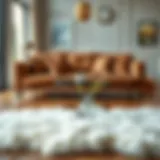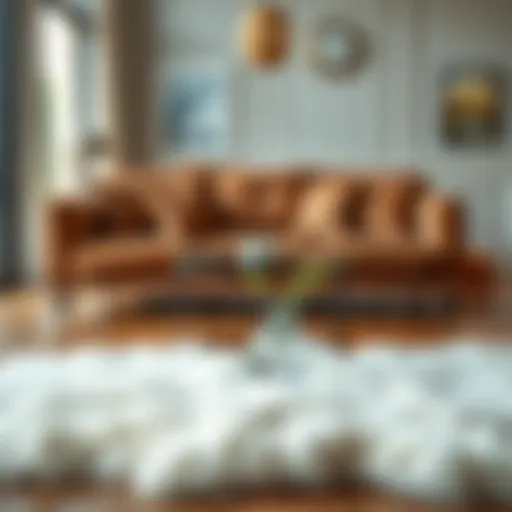Smart Peel and Stick Tiles for Modern Bathrooms
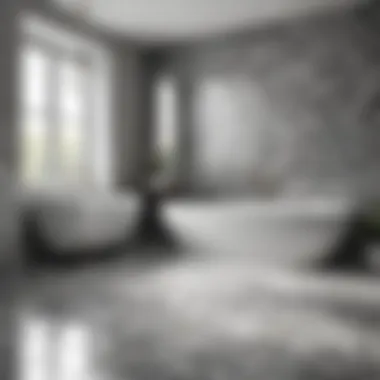
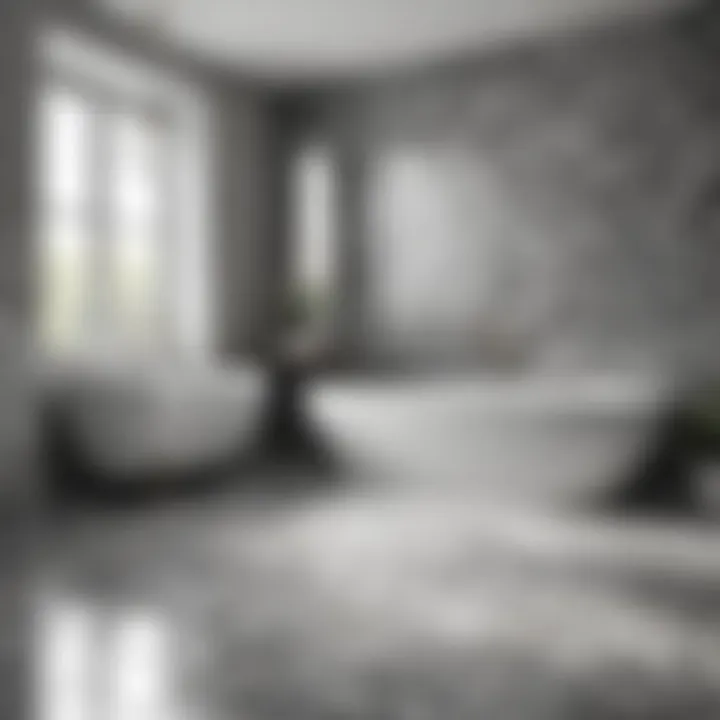
Intro
In recent years, the landscape of interior design has undergone a significant transformation, with an emphasis shifting towards innovative and practical solutions that enhance both aesthetics and functionality. One such solution gaining traction is the use of smart peel and stick tiles, particularly in bathrooms. With their versatility and ease of use, these tiles offer a fresh approach to bathroom design that can cater to a variety of styles and preferences. Whether you’re a homeowner looking to refresh your space, a designer seeking unique solutions, or a DIY enthusiast eager to tackle a new project, understanding the utility of these tiles is essential.
Why Smart Tiles?
Smart peel and stick tiles are designed for ease and efficiency. They provide an attractive alternative to traditional tiling methods, saving both time and effort. When it comes to bathrooms—usually characterized by moisture and limited space—these tiles prove to be exceptionally user-friendly. They can be applied directly to existing surfaces without the need for messy adhesives or time-consuming installation processes.
"Peel and stick tiles allow anyone, regardless of skill level, to achieve a professional-quality look."
Moreover, the range of designs available has expanded tremendously. From sleek, modern aesthetics to more traditional appearances, there's likely a tile that fits the vision of any bathroom. With the resilience against moisture, cleaning becomes a breeze, making them an ideal choice for high-traffic areas.
Now, let’s take a closer look at some current trends in bathroom design, particularly as they relate to the application of these smart tiles.
Foreword to Smart Peel and Stick Tiles
When diving into bathroom design, the materials you choose play a critical role in both functionality and aesthetics. Among the various options available today, smart peel and stick tiles have emerged as stellar contenders, particularly favored for their versatility and ease of use. This section serves as a foundation to understand what these tiles are, their application in the bathroom setting, and why they might just be the game-changer you're looking for.
Defining Smart Tiles
Smart tiles are essentially adhesive tiles that are engineered for modern spaces. Unlike traditional tiles that require arduous installation processes involving cement, grout, and hours of labor, smart tiles come with a self-adhesive backing, allowing for a straightforward application. They are made from high-quality materials that ensure durability and longevity—a must-have quality in moist environments like bathrooms.
For homeowners looking to transform their space with minimal hassle, smart tiles open up a realm of possibilities. They are not only available in a barrage of designs but also can be removed and replaced without having to tear down walls or spend a fortune. This makes them particularly appealing for those who may change their minds or designs frequently.
The Concept of Peel and Stick
The concept of peel and stick is pretty self-explanatory but carries a significant weight in practical terms. Imagine having the freedom to change your bathroom's look without the headache of an overhaul. The ease of installation is perhaps the most significant advantage. Just peel the tile from its backing and stick it onto a clean, dry surface. It’s as simple as that!
Here’s a quick breakdown of the peel and stick advantages:
- User-Friendly: Designed to be low-maintenance and easy to apply, even for those who may not consider themselves DIY experts.
- Quick Transformation: Revamping your bathroom can be achieved in a matter of hours instead of days or weeks.
- Flexible Choices: If you've chosen a design that no longer speaks to you, swapping tiles is on the table without breaking the bank.
"The connection between peel and stick tiles and the modern desire for convenience can't be overstated. It’s about making design accessible to everyone."
In summary, smart peel and stick tiles present a compelling option for those who value style and simplicity. They are not just a trend but an evolution in bathroom design, harmonizing both practical needs and aesthetic dreams.
Advantages of Using Smart Tiles in Bathrooms
When considering a bathroom remodel, the choice of materials can often leave homeowners feeling like they're caught between a rock and a hard place. Traditional tiling methods require significant investment in both time and finances, which leads many to explore alternatives. That’s where smart peel and stick tiles come into play. This section aims to dissect the intrinsic benefits of using these innovative materials in bathroom design.
Ease of Installation
One of the standout features of smart peel and stick tiles is their straightforward installation process. Homeowners with little to no experience in DIY projects can typically tile their bathrooms without hiring an expensive contractor.
- No specialized tools are needed, just a few basic materials like a level and a utility knife.
- The self-adhesive nature simplifies the process, making it feel less like a chore and more like a fun new project.
Many users report that they can complete their bathroom tiling in a single afternoon. This significantly lowers the overall disruption in the household, as it keeps renovations timely and efficient. In essence, smart tiles turn the daunting task of tiling into a manageable and enjoyable experience.
Time and Cost Effectiveness
Smart peel and stick tiles are a game-changer for budget-conscious homeowners. The initial expense is typically lower than that of traditional options, which can involve not just the tiles but also mortar, grout, and other materials. But it doesn't stop there.
- Costs related to labor can practically disappear since installation can be a one-person job.
- Additionally, the time saved translates into financial savings; less time spent on installation means that you can move on to other renovations sooner.
Furthermore, smart tiles have also been known to last long without needing significant repairs, so those who worry about future expenses regarding upkeep can find peace of mind. These factors combined create a compelling case for a financially savvy option that doesn’t sacrifice style.
Durability and Maintenance
The durability aspect of smart peel and stick tiles truly shines in bathroom settings, where humidity and moisture often reign supreme.
- Made from quality materials, these tiles are generally resistant to water damage and mold, a significant advantage over some conventional materials.
- Their surface is easy to clean—often requiring just a damp cloth to remove dust and grime, drastically reducing time spent on cleaning.
In cases where damage does occur, most tiles can be removed and replaced without complete re-installation, which is a huge plus for homeowners. This ease of repair solidifies smart tiles as a reliable choice, catering well to the ongoing demands of bathroom spaces.
Using smart peel and stick tiles offers a blend of practicality and style, perfectly suited for modern bathrooms.
In summary, the advantages of implementing smart peel and stick tiles in your bathroom design are clear. From ease of installation to cost effectiveness and durability, these elements unite to form an appealing package for any homeowner. As such, it becomes less of a question of 'if' and more of a question of 'when' to embrace this innovative approach.
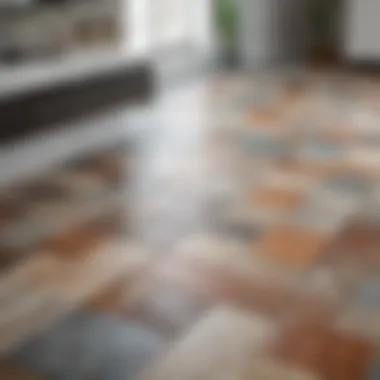
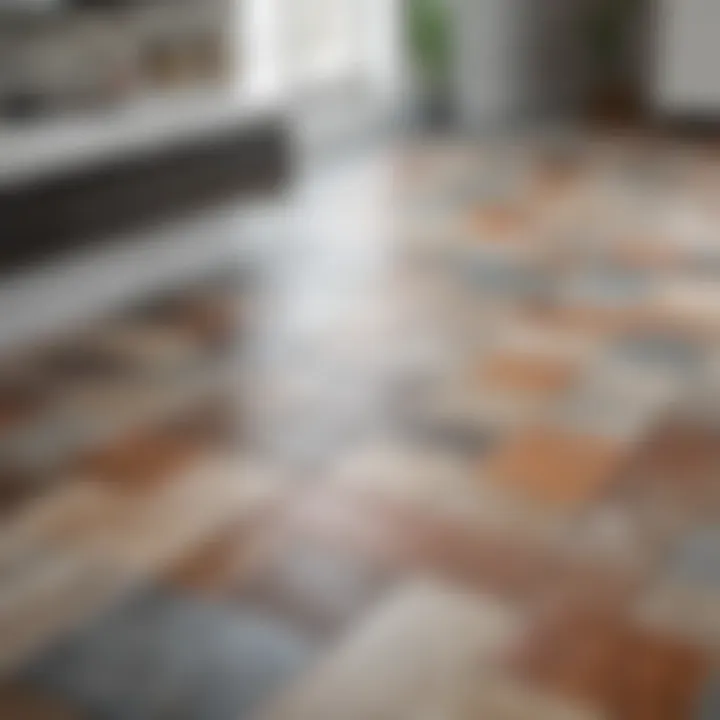
Design Options and Aesthetic Appeal
When considering bathroom renovations, the design options can carry just as much weight as the practicality of the materials. Smart peel and stick tiles bring a fresh perspective to bathroom aesthetics, allowing homeowners and designers alike to create spaces that are not only visually appealing but also functional. The blend of design choices, ease of installation, and unique styles can significantly impact the overall vibe of a bathroom. It’s about making a statement and maximizing every inch of space.
Variety of Styles
One of the most compelling reasons to choose smart tiles is the variety of styles available. From sleek, modern looks to rustic, traditonal designs, there is an option that fits almost every taste and preference. Homeowners looking for a minimalist aesthetic might gravitate towards monochrome patterns, which can make a space look larger and cleaner. On the other hand, those with a love for maximalist decoration can opt for intricate patterns or bold colors that add a touch of personality to the environment.
Also, tiles can mimic natural materials like wood or stone, allowing for a luxurious look without the hefty price tag. For example, a bathroom adorned with smart tiles that mimic marble can instill an air of elegance—a stark contrast to the practical benefits of quick application and easy maintenance. The diversity means that even a small bathroom can be transformed from bland to bold.
Color and Texture Considerations
Color plays a pivotal role in any design scheme, especially in a space like a bathroom where lighting conditions can change how colors appear throughout the day. When choosing smart tiles, it’s wise to consider not just the color but also the texture of the tiles. Glossy finishes can reflect light, making a small space feel more expansive, while matte textures can impart a cozy, intimate vibe.
The choice of colors can also influence mood. Soft, pastel shades can promote calm and relaxation, which is probably what most people seek in a bathroom. Meanwhile, vivid hues might be ideal for energizing a dull space, perfect for someone who wants an invigorating experience. With smart peel and stick options, you can experiment with layering different colors and textures for a more dynamic look.
Combining with Existing Decor
An exciting aspect of smart peel and stick tiles is their versatility in combining with existing decor. This flexibility allows for seamless integration into various design themes, whether you’re working with modern fixtures or vintage pieces.
When selecting tiles, consider how they will complement existing elements in the bathroom—think about cabinetry, fixtures, and even towels. For instance, a classic white tile might beautifully accentuate dark wood cabinets, while geometric tiles can modernize a space dominated by traditional fixtures.
Moreover, the tactile experience of tiles, such as pairing smooth tiles with the rustic charm of wicker baskets, can create intriguing contrasts. The key is to create a cohesive design that ties all elements together—making your smart tiles not just a part of the decor, but a central feature that enhances the overall aesthetic.
"Choosing the right design options is paramount; they can elevate a simple bathroom into a sanctuary."
Step-by-Step Guide to Installation
Installing smart peel and stick tiles in your bathroom isn’t just a task; it’s a rewarding journey that allows you to transform your space with a touch of flair and function. This guide breaks down the installation into manageable parts, ensuring that whether you’re a seasoned DIYer or just giving it a go, you’ll feel confident in your ability to install these stylish tiles. The significance of this topic lies in its capacity to empower homeowners, designers, and DIY enthusiasts to take control of their bathroom aesthetics without needing a professional's intervention.
Preparing the Surface
Before diving into the installation of peel and stick tiles, it’s crucial to prepare the surface where they will be applied. Cleaning the area thoroughly before you start is paramount. Remove any dirt, soap scum, or old adhesive residues. A clean surface ensures that the tiles adhere properly and last longer. Don’t skip the step to patch any holes or cracks; they will weaken the bond between the tile and the wall.
Consider this checklist for surface preparation:
- Clean the surface: Use a damp cloth or sponge with a mix of vinegar and water.
- Dry thoroughly: Make sure the surface is completely dry before applying tiles.
- Level the surface: If your walls have imperfections, using a spackle to even them out can help.
Getting the groundwork right here can make or break the entire project. A well-prepped area leads to a neater finish and less hassle down the road.
Placement and Alignment Techniques
The placement of your tiles can indeed make or break the look of your new bathroom. Start by marking a straight line (using a level) where you want the tiles to start. It’s generally recommended to begin from the center of the wall or a focal point, working your way outwards to create a balanced appearance.
Here’s what to do:
- Measure and mark: Use a measuring tape to find the center of the wall. Mark it lightly with a pencil.
- Lay out your tiles: Before sticking anything down, lay out the tiles without removing the backing to see how they will fit.
- Cutting tiles: When you reach edges or fixtures, you may need to cut tiles to fit. A utility knife makes quick work of this.
- Stick with precision: Peel off the backing, align the tile properly and press firmly from the center outward to eliminate air bubbles.
Alignment is key here; after all, a crooked tile will stare at you like a sore thumb long after installation.
Sealing and Finishing Touches
Once the tiles are in place, you’re not quite done yet. Sealing and finishing touches are what will ensure that your installation is both beautiful and functional. Depending on the type of smart tiles you choose, you might consider sealing them for added durability, particularly if they're in a high-moisture area.
Steps for sealing and finishing:
- Inspect your work: Take a close look at the installation for any misaligned tiles or gaps.
- Apply a sealant: If needed, apply a clear epoxy sealant to prevent moisture damage.
- Grout lines (if applicable): If using grout with your tiles, this will add a polished appearance and help with water resistance.
Successfully finishing your installation isn’t just about how it looks but how it will hold up against wear and tear.
Maintenance of Peel and Stick Tiles
Keeping your smart peel and stick tiles in tip-top shape involves more than just the initial installation. Long-term maintenance is key to sustaining their beauty and functionality. A well-maintained tile not only preserves the aesthetic of your bathroom but also extends the life of your investment. Regular upkeep ensures that these clever solutions remain as stunning as the day they were installed, highlighting their practical advantages in home design.
Routine Cleaning Practices
Cleaning your tiles doesn’t require a PhD or flashy gadgetry; it is often about common sense and some elbow grease. Here’s how to keep your tiles looking fresh:
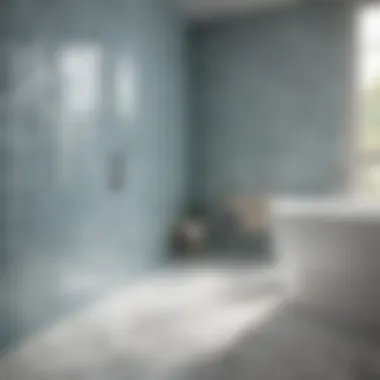
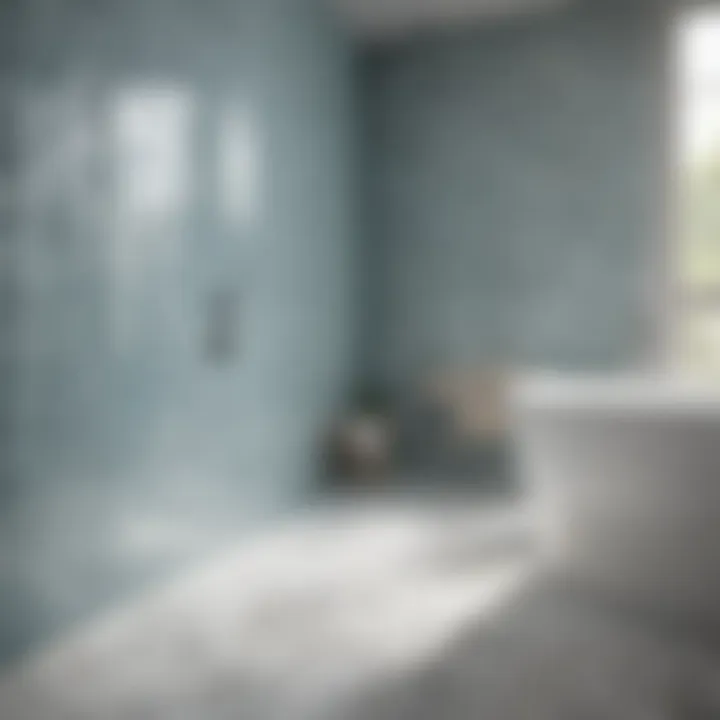
- Gentle Cleaning Solutions: Opt for mild soapy water or vinegar-based solutions. Steer clear of harsh chemicals that can degrade the tile or adhesive over time.
- Soft Cloth or Sponge: When it’s time to scrub, use a soft cloth or a non-abrasive sponge. This will help prevent scratches that could mar the surface.
- Regular Schedule: Setting a regular cleaning schedule can make all the difference. Whether weekly or monthly, sticking to a routine will keep dirt and grime at bay. Don’t wait until your tiles start to look dingy.
"An ounce of prevention is worth a pound of cure." When it comes to maintaining your smart tiles, regular cleaning can save you potential headaches down the line.
- Avoid Excessive Moisture: Especially in bathrooms, where humidity can be high, make sure to ventilate well. Too much moisture can lead to mold or mildew, which is the last thing you want over your delightful tiles.
- Watch for Stains: If spills happen, tackle them promptly. The sooner you address a spill, the easier it is to clean it up without leaving a stain.
Addressing Damage or Wear
No matter how sturdy, even the best peel and stick tiles can experience wear and tear over time. Knowing how to address issues when they arise can save you from costly replacements.
- Inspect Regularly: Make a habit of checking your tiles for any signs of damage, like peeling or bubbling. Catching issues early can simplify repairs.
- Repairing Minor Issues: For small peeling edges, carefully lift and reapply the tile. A little heat from a hair dryer can help loosen adhesive, making it easier to reposition.
- Replace Damaged Tiles: If a tile is beyond repair, don’t fret. Ordering a replacement tile is usually straightforward. Just be sure to keep an eye on the style to ensure it matches well.
- Re-sealing: If you notice wear on the tiles or if they’re exposed to a lot of humidity, consider re-sealing them with a compatible sealant. This adds a layer of protection and helps them withstand bathroom conditions better.
- Professional Help for Major Repairs: If you're feeling overwhelmed or the damage is significant, calling in a pro isn’t a bad idea. Sometimes expertise can save you a boatload of trouble.
Proper maintenance isn’t rocket science, but it takes a bit of attention. With just a little effort, smart peel and stick tiles can remain a vibrant, functional part of your bathroom for years to come.
Environmental Considerations
In today’s eco-conscious world, environmental considerations are more crucial than ever, especially when it comes to home renovations and design choices. Smart peel and stick tiles, while stylish and functional, also carry significant implications for sustainability and indoor air quality. Homeowners, designers, and DIY enthusiasts are increasingly looking for options that not only enhance the beauty of a space but also contribute positively to the environment. Understanding these elements can guide the decision-making process in choosing the right materials for your bathroom.
Sustainability of Materials
When evaluating smart peel and stick tiles for bathroom design, sustainability ranks high on the checklist. Many of these tiles are made from recyclable materials, which reduces the overall environmental impact. For instance, certain brands utilize vinyl that is free from harmful chemicals like phthalates, making them a safer choice for both health and the planet.
Additionally, since these tiles are ease to install, the energy required for installation is lower compared to traditional tiles, effectively cutting down on resource consumption. This aspect can be a game changer. Homeowners can contribute to conserving various resources, from manpower to energy, simply by selecting smart tiles over conventional options.
"The home improvement industry is gradually shifting towards greener practices, and smart tiles neatly fit into this narrative of sustainability."
Some smart tile manufacturers are shifting focus towards producing eco-friendly products with minimum waste during the production process, further amplifying their sustainable offerings. Companies that embrace this direction often highlight their commitment to a lower carbon footprint, aligning their practices with the growing consumer demand for environmentally responsible products.
Impact on Indoor Air Quality
Indoor air quality is a pressing matter that shouldn’t be overlooked when refurbishing a bathroom. Smart peel and stick tiles generally emit fewer volatile organic compounds (VOCs) compared to traditional tiling materials. VOCs can be detrimental to indoor air quality, causing a variety of health issues over time.
Using tiles that are designed with health-conscious materials can help in mitigating these concerns. For example, some brands specifically advertise that their products are low in VOCs, providing peace of mind to the homeowner. In bathrooms, where moisture and humidity levels can lead to mold growth, maintaining healthy air quality is critical.
Here are several factors to consider regarding indoor air quality:
- Material Composition: Check for certifications that confirm the tile’s low VOC content.
- Installation Process: Opting for tiles that don’t require adhesives or special chemicals can further promote a fresher indoor environment.
- Maintenance Practices: Regular upkeep not only enhances aesthetics but also helps in sustaining good air quality.
Ultimately, the choices made in selecting materials and design options do have a lasting impact. Homeowners can enjoy their aesthetically pleasing bathroom while also fostering a healthier environment, reinforcing the idea that design choices can indeed harmonize with sustainable living.
Comparative Analysis: Smart Tiles vs. Traditional Tiles
In the realm of bathroom renovation, comparing smart peel and stick tiles to traditional tiling methods sheds light on several critical factors that influence homeowners’ decisions. The transition from conventional methods to more innovative solutions like smart tiles is not just a matter of aesthetics but also encompasses considerations of cost, time, and long-term value. By examining these elements, one gains a clearer picture of why smart tiles may be the preferable option, particularly for those who value efficiency in both installation and maintenance.
Cost Comparison
When it comes to costs, the financial implications of choosing smart tiles versus traditional tiles can be a game-changer.
- Smart Tiles: Typically, smart peel and stick tiles come at a fraction of the price of conventional tiles. While the average price per square foot for traditional tiles can range significantly, smart tiles often present a price point that appeals to budget-conscious homeowners. Not only is the material itself usually less expensive, but by eliminating the need for adhesive and grout, further savings accumulate.
- Traditional Tiles: On the flip side, traditional tiles, though often perceived as high-quality or luxurious, require higher upfront investments. This includes the costs tied to purchase, installation, adhesives, and the potentially costly labor of professional tilers. As a result, the overall expenditure can significantly outweigh the initial allure of a standard tile layout.
Considering the price tags associated with each option, the smart tiles solidify their advantage in cost-effectiveness. Homeowners can enjoy a stylish surface without the financial strain.
Time Investment in Each Method
In terms of installation time, there's a noticeable divide.
- Smart Tiles: One of the standout features of peel and stick tiles is their ease of installation. The process can often be concluded in only a few hours, depending on the size of the space. Simply peel off the backing and apply the tile directly onto the surface, making it a true DIY-friendly project. This speed not only allows homeowners to return to their daily routine swiftly but also minimizes the overall inconveniences associated with home renovations.
- Traditional Tiles: In contrast, installing traditional tile takes quite a bit longer, often stretching into days or even weeks. Laying tiles involves multiple steps: preparing the surface, applying adhesive, setting the tiles, grouting, and allowing time for drying. This lengthy process can be particularly disruptive for those living with ongoing revitalization projects in their bathrooms, as everyday activity can be delayed.
Longevity and Resale Value
Lastly, evaluating durability and the potential return on investment is crucial for informed decision-making.
- Smart Tiles: While they do offer durability, they are often not as impervious to wear and tear as traditional tiles. Smart tiles typically stand up well against moisture but might not be as resilient to heavy impacts, leading some to question their long-term viability.
- Traditional Tiles: On the other hand, conventional ceramic or porcelain tiles are renowned for their longevity and ability to withstand the rigors of daily use and water exposure. This resilience often translates to greater resale value for homes, as buyers tend to favor bathrooms that boast classic construction methods. Many prospective homeowners view high-quality traditional tiles as a sign of lasting quality, which can be a selling point.
"The choice between smart and traditional is about more than just the here and now; it’s about where you see your home in the future."
Ultimately, the comparative analysis of smart peel and stick tiles against traditional options reveals critical insights. Cost savings, swift installations, and aesthetic flexibility tip the scale towards smart tiles for many modern homeowners. However, durability and perceived value might warrant a deeper consideration of traditional methods for the discerning homeowner.
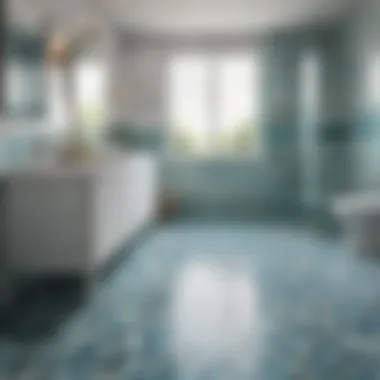
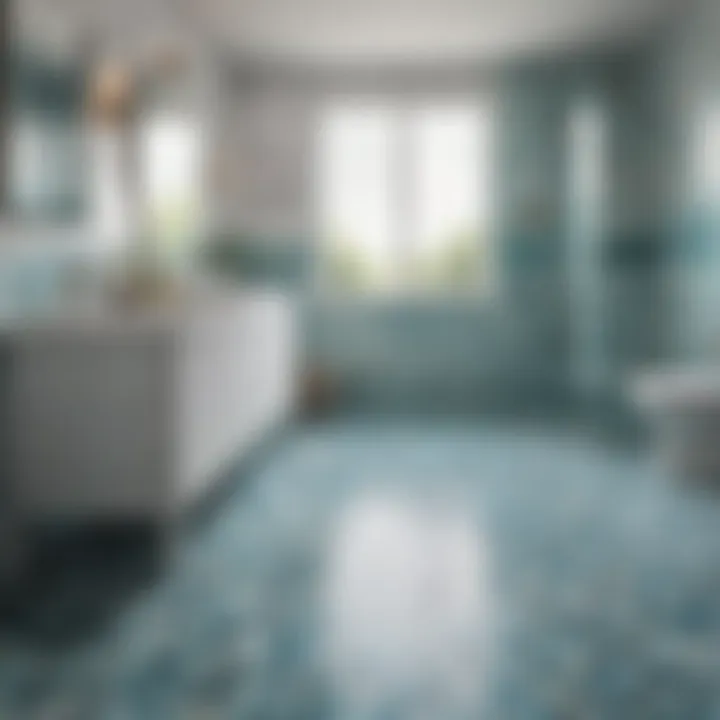
Case Studies of Successful Bathroom Transformations
When it comes to home renovations, particularly in spaces as intimate as a bathroom, case studies serve a crucial role in showcasing how creativity and practicality can unite. The narrative gathered from real-life bathroom transformations illustrates the manifold benefits of utilizing smart peel and stick tiles. These stories not only inspire, but they also provide insight into design strategies, problem-solving techniques, and the impact of these innovative tiles on overall aesthetic appeal.
Here are some elements that stand out in these case studies:
- Real-World Applications: Observing how homeowners and designers implement smart tiles can spark ideas on personalization, functionality, and style.
- Visibility of Versatility: A diverse range of designs and styles will often shine through in these stories, demonstrating the adaptability of peel and stick tiles.
- Assessment of Challenges Overcome: Challenges encountered during installation or selection often come to light, providing valuable lessons and solutions for readers.
- Cost and Time Efficiency: Many of these transformations highlight how time-saving methods lead to cost-effective renovations without sacrificing quality or style.
In short, case studies illuminate the journey and payoff of integrating smart tiles into bathroom designs. They highlight that transformation is not merely about aesthetics but also about upgrading functionality and enhancing the homeowner's experience.
A Modern Minimalist Approach
Taking a minimalist route in bathroom design emphasizes simplicity and clean lines, often leaning heavily on a neutral color palette. One notable case involved a modest-sized master bathroom that had undergone a complete overhaul with smart peel and stick tiles.
The homeowners opted for white subway-style tiles with a very subtle texture, ideal for creating an airy feel. With the application of these tiles, the space appeared larger, reflecting light effectively. The choice for a matte finish helped maintain an understated elegance.
Beyond just looks, the installation process was swift, taking merely a weekend. The result was a bathroom that felt serene and uncluttered.
Key Takeaways from This Case:
- The use of smart tiles allowed a quick transformation without the mess and elaborate setup of traditional tiling.
- Simple color schemes paired with textured tiles can create depth and style, aligning perfectly with minimalist philosophies.
- Homeowners reported feeling an increase in mental clarity and relaxation, stemming from the uncluttered space.
Maximalist Designs with Smart Tiles
In contrast, maximalism in bathroom design embraces bold choices and eccentric combinations. A vibrant example involves a renovation in an older Victorian home, where the owners decided to express their eclectic tastes through a dizzying mix of colors and patterns.
Smart peel and stick tiles were at the forefront of this ambitious project. The kitchen backsplash tiles were chosen for their lively geometric designs in deep blues and yellows, creating a striking backdrop.
In this case, the rapid installation of tiles allowed the homeowners to test combinations without significant risk. Adjusting a tile or changing alignments was as easy as peeling them back and repositioning. They even mixed them with traditional materials in other parts of the bathroom.
Highlights from This Renovation:
- Maximum expression through tiles permitted owners to explore robust designs without lengthy renovations or substantial costs.
- Quick adjustments gave homeowners the flexibility to experiment, achieving a look that eventually felt cohesive yet playful.
- Compliments from guests on the boldness highlighted the ability of smart tiles to make a statement.
Both the minimalist and maximalist approaches illustrate the endless potential of smart peel and stick tiles in bathroom transformations. By integrating thoughtful design with practical solutions, these case studies serve as a powerful motivator for anyone looking to innovate in their bathroom spaces.
Future Trends in Tile Technology
As we look ahead, the field of tile technology is rapidly evolving, driven by innovation and the challenges of modern home design. This segment is not just a passing phase but reflects a larger movement toward smarter, more efficient home improvement solutions. For homeowners and designers alike, understanding these trends is essential for staying ahead in style and functionality.
Innovative Materials and Designs
One of the most significant shifts is the development of innovative materials that go hand in hand with smart peel and stick tiles. These modern materials are often lighter, more waterproof, and environmentally sustainable. You’ll find tile options that bend the rules of traditional designs; for example, peel and stick tiles made from recycled plastics or bamboo fibers.
Key features of these innovative materials include:
- Lightweight Composition: Easier to handle, which simplifies installation for DIY enthusiasts.
- Eco-Friendly Options: Many contemporary tiles prioritize sustainability, using materials that support a greener environment.
- Advanced Durability: Scratch-resistant and humidity-proof designs minimize wear and tear, ideal for bathrooms that experience frequent moisture.
The array of designs available is also expanding, with styles ranging from sleek minimalist looks to vibrant patterns that can revitalize any space. Customization is becoming more common, allowing homeowners to pick patterns that cater to their personal aesthetic without sacrificing practicality.
Integration with Smart Home Systems
The intersection of tile technology and smart home systems is a frontier waiting to be fully explored. Imagine tiles that not only beautify your walls but also interact with a smart thermostat or lighting system. Integrating peel and stick tiles with smart technology could enhance energy efficiency in bathrooms, allowing for automated adjustments based on usage patterns.
For example:
- Smart Lighting Integration: When paired with automated lights, tiles could change colors to match your desired ambiance, allowing for a unique bathing experience.
- Sensors for Temperature Control: Tiles that respond to temperature changes can help maintain a comfortable environment by communicating with HVAC systems.
In summary, as smart home technology continues to permeate our daily lives, the future trends in tile technology are promising not just for aesthetic advancements but also for increased functionality. Investing in these innovations today can transform your bathroom into a harmonious blend of style, technology, and efficiency.
Epilogue
In wrapping up the discussion on smart peel and stick tiles, it’s clear that these innovative products carry significant weight in the world of bathroom design. The convenience they present is akin to having a handy toolbox at your disposal; you can tackle renovations without the laborious task of traditional tiling methods. These tiles combine functionality with an expressive flair, elevating bathrooms that might otherwise feel plain or outdated.
Summarizing Key Points
The advantages of smart tiles are plentiful:
- Ease of Installation: Homeowners can skip the need for professional help. The peel and stick feature eliminates the messiness of adhesives and mortar.
- Cost-Efficiency: Compared to traditional tiles, smart tiles often lead to noticeable savings, both in material and installation costs.
- Design Versatility: With a multitude of styles, colors, and textures, homeowners can curate their desired aesthetic without being boxed into conventional designs.
The case studies shared earlier demonstrate the profound impact these tiles can have in transforming spaces, whether it’s a modern minimalist look or an intricate maximalist design. Coupled with future trends in material innovation and smart home integration, the potential developments in this area seem promising.
Encouragement for Exploration
So, to all homeowners, designers, and DIY enthusiasts out there, why not take the plunge into the world of smart peel and stick tiles? Embrace the opportunity to express your creativity while enjoying the functionality they bring. Just as a painter wields a brush, you too can wield these tiles to revamp your space into something that reflects your vision and meets your needs. Don’t settle for the ordinary when you can achieve extraordinary results with relative ease. The bathroom isn’t just a practical space; it can be a canvas for design and expression.






